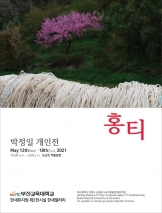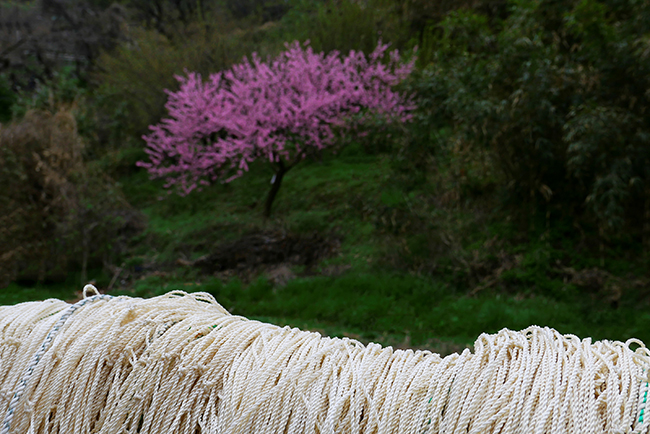상세정보
작가의 글
부산에 위치한 홍티 마을은 무지개 언덕과 함께 낙동강이 유입되는 하구와 연결된 포구 마을이다. 지금은 마을의 서쪽 해안에 무지개 공단이 조성되었고, 해안은 좁은 수로의 형태로만 남아 소형 선박들이 정박하고 있다. 공단의 조성으로 산기슭의 일부를 제외하고는 아름다운 마을은 흔적도 없이 사라졌고, 포구의 기능도 거의 상실되었다. 더군다나 하구 둑 건설 이후 약해진 조류 탓으로 어자원은 크게 줄어들었고, 대신 공단의 기계소리와 외국인 노동자들의 일터로 바뀌어버린 지도상의 어디에도 없는 마을이 되었다.
도시는 개발과 현대화라는 속성을 가지며 그 속에 잠재하는 욕망의 에너지는 하늘의 한쪽 끝을 삼킬 만큼 강하다. 급속하게 변해가는 개발 속에서 초라하게 방치된 포구와 몇 푼 안 되는 보상금으로 고향을 잃고 도시 빈민으로 내몰린 주민들의 안타까운 모습은 이미 오래전 사람들의 기억으로부터 잊혀졌다. 도시의 과도한 개발과 변화가 불가피한 현실이라면 이러한 과정 속에서 지역 주민과 환경의 훼손을 최소화하여 함께 공존할 수 있는 방법의 모색도 우리의 과제이다. 더군다나 항구와 물의 도시 부산을 무조건 도시의 속성으로만 몰아가며 파괴와 해체의 역사로만 기록하고 보아야 할 것인가는 좀 더 깊은 고민이 필요하다.
모든 존재는 오래전부터 생성과 소멸을 반복해왔고 이는 영원히 되풀이 되고 있다. 변화하지 않는 영원성의 개념에 대한 문제 제기와 그것의 갈망은 존재의 유한함을 자각하는 순간부터 시작된다. 살면서 마주하게 되는 인간의 죽음이나 사물의 소멸은 우리로 하여금 두려움을 느끼게 하며 더욱 영원함에 집착하도록 만든다. 죽음이 삶과의 단절이 아닌 새로운 시작임을 암시하는 종교적 접근은 동양의 순환원리인 삼사라이기도 하다.
플라톤은 동굴의 비유에서 시간이 흐르면서 사라지는 불완전한 그림자가 아니라 시간과 공간을 초월한 참된 것을 인식하려 했다. 이는 일반적으로 경험되는 감각적인 알아차림이 아니라 깊이 은폐되어있는 그 본래의 소여성에 대한 인지이며, 오로지 우리의 이성으로서만 자각할 수 있다고 한다. 나는 이번 작품을 통해서 시간 속으로 사라지는 ‘홍티 마을’을 기록하고, 하나의 연결된 선상에 놓인 삶과 죽음의 순환성을 사진으로 표현하고 싶었다. 마을주민의 대부분이 떠나버린 프레임속의 기호와 상징들은 시각적인 무의식을 지시하고, 이를 통해서 감상자는 장막으로서의 그림자를 걷어내길 원한다. 몰운대 위에서 석양을 보며 사라지는 홍티 마을의 안타까운 죽음을 느끼기도 하지만 순환으로서의 영원함을 인식하며 ‘변하지 않음’이라는 것에 집착하지 않기로 한다. 촬영 기간 마을의 빨래터에서 만난 101세의 최고령 할머니가 노환으로 돌아가셨고, 마을 어귀에 끊임없이 얽혀있는 그물의 뒤편에는 복사꽃이 또 한 번의 봄을 알리고 있다.
Artist statements
Hong-ti Village in Busan is a port village connected to the Rainbow Hill and the downstream area of Nakdonggang River. Today, the Rainbow Industrial Complex can be found at the village’s western coast. Small boats are moored off the coast, which has become more of a narrow canal. The complex has wiped out all traces of the village, except a small part at the foot of the mountain, and almost destroyed its function as a port. Fish populations have decreased significantly with currents weakened since the building of a bank at the estuary. Replaced by the workplace of foreign laborers and sounds of industrial machines, the village does not exist even on maps.
Cities, associated with development and modernization, are driven by a raw, innate energy of desire. Amid the rapid changes, the plight of the villagers who have lost their homes in exchange for limited monetary compensation and the dismal abandoned port have long been forgotten in the minds of people. If urban development is absolutely inevitable, our task is to find solutions for co-existence while minimizing damage caused to the locals and the environment. Deeper thought should be given to whether driving urban qualities into Busan, a city of ports and water, is necessary, as well as its place in history as a chapter of destruction and dissolution.
All beings experience birth and death, and this cycle is repeated for eternity. The desire for unchanging eternal life begins from the moment when one becomes aware of his or her finiteness. The death of humans or things that we naturally encounter in life evoke a sense of fear, causing us to obsess over the eternal. The religious concept of the cyclicality of all life and matter, which views death as a new beginning, is called Saṃsāra.
In his allegory of the cave, Plato highlighted the form of the good that transcends time and space over incomplete shadows that disappear over time. This refers to perceiving the essence of the given, achieved through human reason, rather than typical experiences based on our senses. Through this work, I wanted to record the disappearance of Hong-ti Village over time, and adopt an aesthetic approach to the cycle of life and death. The signs and symbols in a frame deserted by most villagers stimulate the visual subconscious, and viewers develop a desire to remove the shadow and its silencing effect. While watching the sunset from Molundae Cliff, I felt remorse over the demise of Hong-ti Village, but at the same time, reminded myself of the eternal cycle and decided not to cling to “that which does not change.” During the filming period, a 101-year-old woman—the oldest in the village—I met at the wash place passed away due to illness. Behind the constantly intertwined net, radiant flowers announce spring.
작가 약력
박 정일은 경북대학교 대학원에서 응집물질물리학이론으로 박사를 하고, 시간과 공간 속에서 끓임 없이 순환하는 자연과 사회현상에 관심을 가지고 기록하고 있다. 2019년에는 홍콩의 민주화 시위현장을 직접 기록한 <Hong Kong 2019>와 <Conical Pendulum>, <Ensemble of Time>, <홍티>의 개인전을 각각 전시하고, 다수의 단체전과 국제전에 참여해오고 있다.



